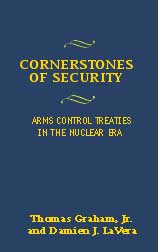Cornerstones & Security: Arms Control & International Law in a Nuclear Era
 This anthology presents the complete text of thirty-four treaties that have effectively contained the spread of nuclear, biological, and conventional weapons during the Cold War and beyond. The treaties are placed in historical context by individual commentaries from noted authorities Thomas Graham Jr. and Damien J. LaVera, which provide unique insights on each treaty’s negotiation and implementation.
This anthology presents the complete text of thirty-four treaties that have effectively contained the spread of nuclear, biological, and conventional weapons during the Cold War and beyond. The treaties are placed in historical context by individual commentaries from noted authorities Thomas Graham Jr. and Damien J. LaVera, which provide unique insights on each treaty’s negotiation and implementation.
During the 1990s, numerous arms control agreements were concluded under U.N. or U.S. leadership. In 1995, one hundred sixty-five nations agreed to indefinitely extend the Nuclear Nonproliferation Treaty. Many nations ratified important chemical and biological weapons conventions, a pact to reduce conventional forces in Europe, and agreements to limit testing of weapons of mass destruction. More recent treaties seeking to restrain small arms trafficking and ban land mines are also highlighted and analyzed.
Graham concludes with lessons learned from the collective negotiation and verification history of these treaties, ongoing efforts to limit weaponry, and general observations on the status and effectiveness of these agreements. There is no comparable resource available for diplomats, international lawyers, and arms control specialists.
“Graham’s book is both a memoir and an excellent history of the Arms Control and Disarmament Agency, with which he was involved for more than 30 years. . . . [I]t is an intimate history of events in which he was a major player.”
–Choice
“The SALT, the START, the ABM-Graham had a role in them all, and his detailed descriptions of the skirmishes among presidents, cabinet secretaries, and members of Congress through six White House administrations make for a comprehensive history of American arms control.”
–Publishers Weekly
“Provides a fascinating composite picture of the limits and possibilities of the legal-diplomatic approach to security and arms control. Graham and his colleagues were constantly forced to maneuver between their determined Soviet counterparts and the equally strong-willed politicians and bureaucrats in Washington. . . . Also illuminating are his chapters on the failed SALT II during the Carter and Reagan years and the rise of hard-line critics of arms control, showing the origins of the split in American strategic thinking that continues today. More optimistically, Graham concludes by pointing to the most lasting arms control success: the nuclear Non-Proliferation Treaty, which made the acquisition of nuclear weapons an act of international outlawry.”
-G. John Ikenberry, Foreign Affairs
“[This book] is a very important historical document and will undoubtedly be consulted by historians of arms control and American foreign policy in the late twentieth century. Students of bureaucratic politics and organizational behavior will also find in this book a rich mine of ase study material.”
–Political Science Quarterly, Winter 2003-2003